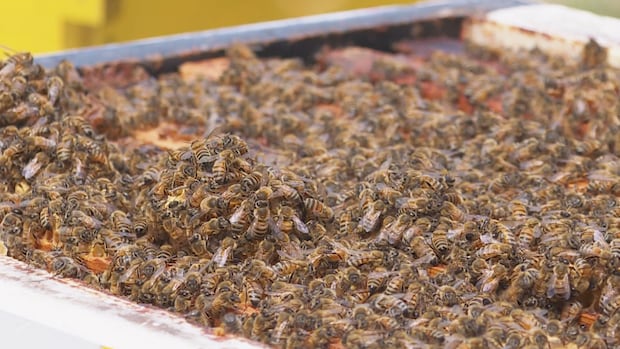Alberta researcher pitches Australian-made beehives as new alternative for Canadian beekeepers

A master beekeeper in Alberta is putting an insulated hive to the test he says could help a struggling Canadian industry.
Sheldon Hill, who works as an educator three hours southeast of Calgary, says an Australian-made product could help change the beekeeping game.
“The sensor data is telling me that the bees are easily able to regulate the area inside their hive much more efficiently,” Hill told CBC News.
He has found that the insulated hive results in a stronger buildup and increased honey production — but it could be a hard sell for an industry that often avoids such big changes.

Hill was a commercial apiarist for three decades in Porcupine Plain, Sask., working for a family of generational beekeepers.
He recently left large-scale beekeeping behind to take on a new role as an educator and researcher with the Prairie Rose School Division in southeast Alberta.
Through a partnership with Medicine Hat College’s Centre for Innovation, Hill is running a year-long test comparing a HiveIQ setup next to a traditional wooden hive at a Neubauer Farms property about five minutes outside Medicine Hat.
His pilot project started in May during the spring buildup and continued into the all-important summer honey producing period.
While Hill cautioned that large-scale research will still be required, he said the hope is that beekeepers, often wary of silver bullets, will be open to the innovative potential of insulated hives.

“I'm really trying to change the minds of the industry because right now a lot of producers don't think much of this concept,” he said.
For over a century beekeepers across the world have relied on a system of stackable wooden boxes known as the Langstroth hive.
In 2011, third-generation beekeeper Victor Croker started developing an insulated solution made out of polystyrene to combat the Australian outback’s extreme heat.
Over a decade later, Croker’s HiveIQ is now being sold around the world — and tested in Alberta by Hill.
While many Canadians may think of insulation as a way to keep something warm in the winter, HiveIQ wanted to keep bees cool with the same method.
“The thermodynamics works both ways in a beehive,” said Robert McBain, who sold Hill the HiveIQ from his Worker and Hive Bee Supply shop.

Bees need their hives at an optimal temperature — over 30 C depending on the season — and the insulated approach can help bees regulate the temperature in both summer and winter.
Those conditions are crucial particularly during the spring when bee colonies are building up for the summer honey production period.
Nathan Reid, North American operations manager for HiveIQ, said Hill’s work is important to get the ball rolling in Western Canada.
“I would rather a beekeeper hear from another beekeeper rather than hear from me,” Reid said.
‘Already invested too much’While insulated hives have existed for a long time, several Alberta beekeepers who spoke to CBC News say it hasn’t been widely adopted because of associated costs and the desire to stick to traditional methods passed down through generations.
Lance Dubeau, a fourth generation beekeeper in St. Lina, Alta., says his equipment has been passed down through his family for decades.
“We’ve been using the same box frame and pallet system since my great grandpa started beekeeping,” said Dubeau, who also a director on the Alberta Beekeepers Commission board.
A new wooden hive can cost the Dubeau farm about $60, he explained, while HiveIQ models can be hundreds of dollars more.
“So it would be pretty hard to convince us commercial guys to run it at scale,” Dubo said.
“But, I think it's a great idea and I love hearing about new opportunities and a new project being done in industry because it is kind of a dying industry."
A transition could prove tricky for hobbyists, too.
Steven and Simone Dold, of S2 Apiary in Bearberry, Alta., started with one hive in 2017 and have since expanded to over 40.
“We’re traditionalists. We use wood frames, we use wood boxes, all of our equipment is woodenware,” Simone said.
She explained that to replace all their gear with new, expensive hives wouldn’t make sense financially.
Wooden boxes, added Steven, are flexible in the way polystyrene isn’t because the beekeepers can mix and match equipment to save costs.
“I don’t mind cutting a hole in our wooden boxes, I can deal with it,” he said.
“But I wouldn’t want to start cutting holes and modifying all the styrene equipment.”
However, the Dolds told CBC News they might advise rookie beekeepers differently.
“If somebody’s just starting out, absolutely. If they look at two different hive bodies and one has better insulating capabilities, that might be the way to go,” said Simone.
“But for us, we’ve already invested too much in what we have.”
Hill acknowledged it will take time to change the minds of the Canadian beekeeping industry but added a made-in-Canada solution could potentially speed it along.

“I’m really trying to change maybe the thoughts of how people are doing things, or maybe the equipment they’re going to build in the future,” he said.
“Or is there an opportunity for a product that’s just more situated towards a Canadian market?”
For now, Hill plans to share his findings widely when his study is fully complete next May.
cbc.ca


